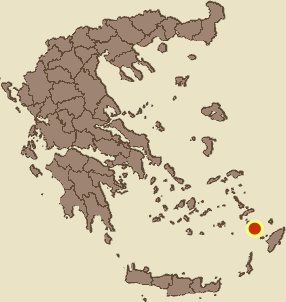Eristos, Tilos, Dodecanese,South Aegean
Paliokastro of Tilos
| Location: |
| At the western side of island Tilos, on the mountain north of Eristos Bay. |
| Region > Prefecture: |  |
| South Aegean Dodecanese | |
| Municipality > Town: | |
| City of Tilos • Eristos | |
| Altitude: | |
| Elevation ≈ 500 m |
| Time of Construction | Origin | |
| Middle Byzantine | BYZANTINE |
|
| Castle Type | Condition | |
| Castle Ruins |
Few Remains
|
A Fortified Byzantine settlement of the “Dark Centuries” on a steep mountain.
Castle Description
Text: Dr. Michael Losse – Singen (Hohentwiel), GermanyGeneral description
In the western part of the island of Tilos rises an isolated mountain massif, which reaches an altitude of 654m with the peak Profítis Ilías. Less than 1 km southeast of the summit, on the slope of an estimated 500m high side peak in a slope trough, lies the Palaiókastro, west-northwest over the large Eristos Bay.
There are visual connections to fortifications on the island of Tílos (amongst others Kástro tó Lámbrou and the ancient fortification next to Taxiarchis church) as well as to the islands of Nísyros, Gýalos, Stróngyli, Kós, Kálymnos, Sými, Séskli, Rhódos (the Rhodian West Coast), Alimía, Chálki, Sariá, and Kárpathos, and to the Minor Asian mainland (Turkey).
The archeologist Haris M. Koutelakis (p. 77) named the Palaiókastro among the "oldest castles in the Byzantine Period" on Tílos, and Gerola (1916, p. 17) considered it identical to the fortification called "stou Kolaksa".
The analysis of the site is difficult due to the later rural settlement of the Palaiókastro, which was associated with structural changes and the construction of arable terraces also within the ring wall. According to the location and the site, it will have been a fortified Byzantine settlement of the so-called “Dark Ages”, which may have been preceded by an ancient settlement. For this purpose, various terraces inside the enceinte and the base of the ring wall in the area of the access side may provide clues. Thus, within the Palaiókastro there are substructures of terraces made of large stones, which – these are merely conjectures – "Mycenian".
The enceinte respectively ring wall consists of solid quarry stone masonry, partly with bricks or brick tweaks. The upper end of the wall is not preserved anywhere in its original state, so that there is no knowledge about a possible defensive structure (wall walk?).
Inside the castle’s enceinte, apart from a large, longitudinal-rectangular cistern, which once spanned a barrel vault, foundations were preserved in mortar masonry, which could come partly from other cisterns and partly from (modern) residential buildings. The large quantities of ceramic fragments and brick splits to be found inside testify an intensive use or settlement of the mountain, the comprehensive archaeological investigation of which would be desirable.
Access (route / entrance)
The Castle is not accessible by paths. It can only be reached on sight via a non-hazardous, steady, time consuming ascent via collapsed and overgrown field terraces and boulders and in the upper part by a sink.
The main access to the castle was on the north-east side; the path led up through sinks, but the original route through the later installation of farm terraces and their temporary decay is no longer comprehensible.
History of the castle
The Palaiókastro was built during the so-called “Dark Ages” in the Byzantine epoch, as Muslim Arab forces threatened many regions of the Mediterranean, but especially the Greek coasts and islands, by raids. Tilos formed part of the naval “Thema” of Samos, a Byzantine military administrative district, from the 9th century.
There is no clear evidence that the Knights of St. John maintained the castle to protect the rural population against Ottoman and pirate raids.
Other Info
SourcesKoutelakis, Haris M.: Tilos. Art, History, Archaeology. Athen (without specifying the year of publication).
Losse, Michael: Burgen und Befestigungen des Johanniter-Ordens auf den Dodekanes-Inseln Tílos, Chálki und Alimiá (Teil 1). In: Burgenforschung aus Sachsen (Editor: Heinz Müller, Deutsche Burgenvereinigung, Landesgruppe Sachsen), Vol. 17/2, 2004, pp. 98-129; Vol. 18/2, 2005, pp. 135-157.
Losse, Michael: Die Burgen und Festungen des Johanniter-Ritterordens auf Rhódos und in der Ägäis (Griechenland) 1307-1522. (Publisher: Nünnerich-Asmus Verlag) Mainz 2017.
Losse, Michael: Burg und Expansion in der Südost-Ägäis: Von den byzantinischen Befestigungen der „Dunklen Jahrhunderte“ (8.-10. Jahrhundert) bis zur Invasion der „Franken“ (13./14. Jahrhundert) und Osmanen (15./16. Jahrhundert). In: Europäisches Burgeninstitut (Ed.): Burg und Expansion (will be released in 2021).
| First entry in Kastrologos: | June 2021 |
Sources
- Article and photographs (2006, 2008) by Dr. Michael Losse, M.A.
|
|
| Access |
|---|
| Approach to the monument: |
| There is no path to the castle. It can only be reached on sight via a non-hazardous, steady, time consuming ascent via collapsed and overgrown field terraces and boulders and in the upper part by a sink. |
| Entrance: |
| Free access |



